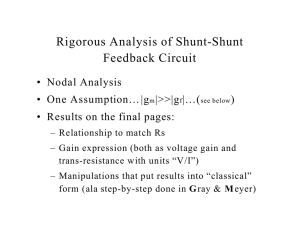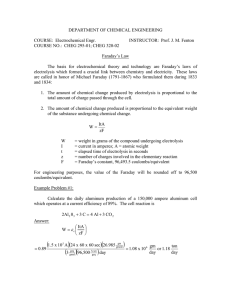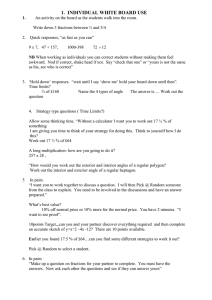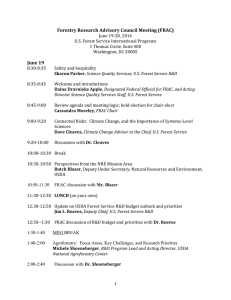of linear recurrences
advertisement
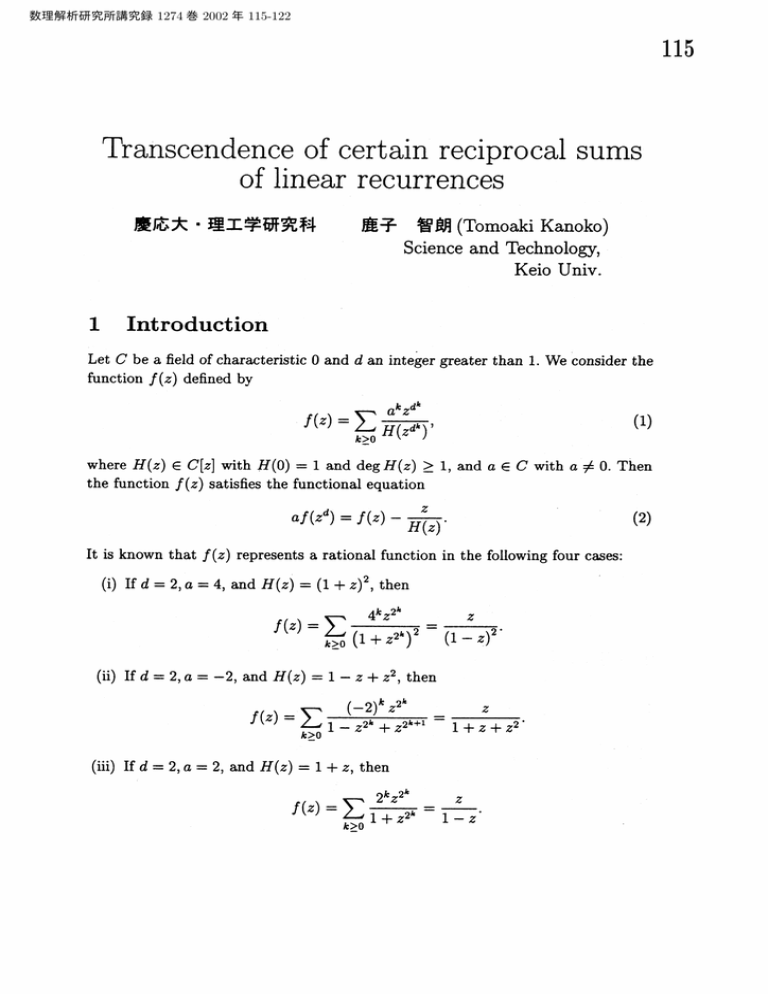
数理解析研究所講究録 1274 巻 2002 年 115-122
115
Transcendence of certain reciprocal sums
of linear recurrences
慶応大・理工学研究科
智朗 (Tomoaki Kanoko)
鹿子
Science and Technology,
Keio Univ.
1
Introduction
Let be afield of characteristic 0and
function $f(z)$ defined by
$C$
$d$
an integer greater than 1. We consider the
$f(z)= \sum_{k\geq 0}\frac{a^{k}z^{d^{k}}}{H(z^{d^{k}})}$
where $H(z)\in C[z]$ with $H(0)=1$ and $\deg H(z)\geq
the function $f(z)$ satisfies the functional equation
,
(1)
1$ ,
$af(z^{d})=f(z)- \frac{z}{H(z)}$
It is known that
$f(z)$
and
$a\in C$
with
$a\neq 0$
. Then
.
(2)
represents arational function in the following four cases:
(i) If $d=2$ , $a=4$ , and
$H(z)=(1+z)^{2}$ ,
then
$f(z)= \sum_{k\geq 0}\frac{4^{k}z^{2^{k}}}{(1+z^{2^{k}})^{2}}=\frac{z}{(1-z)^{2}}$
.
(ii) If $d=2$ , $a=-2$ , and $H(z)=1-z+z^{2}$ , then
$f(z)= \sum_{k\geq 0}\frac{(-2)^{k}z^{2^{k}}}{1-z^{2^{k}}+z^{2^{k+1}}}=\frac{z}{1+z+z^{2}}$
(iii) If $d=2$ , $a=2$ , and $H(z)=1+z$ , then
$f(z)= \sum_{k\geq 0}\frac{2^{k}z^{2^{k}}}{1+z^{2^{k}}}=\frac{z}{1-z}$
.
.
116
(iv) If d
$=2$
,a
$=1$ ,
and
$H(z)=1-z^{2}$ ,
then
$f(z)= \sum_{k\geq 0}\frac{z^{2^{k}}}{1-z^{2^{k+1}}}=\frac{z}{1-z}$
.
It is natural to ask whether there exist rational functions of the form (1) other than
these four cases. The purpose of this paper is to answer this question.
Theorem 1.1. Let $f(z)$ be the function defined by (1). Suppose that $\deg H\leq 3$ .
Then $f(z)$ is a transcendental function over $C(z)$ except in the four cases stated
above.
In the case of a
$\neq 1$
,
we can dispense with the assumption $\deg H\leq 3$ .
Theorem 1.2. Let $f(z)$ be the function defined by (1). Suppose that $a\neq 1$ . Then
$f(z)$ is a transcendental function over $C(z)$ except in the three cases stated above.
We shall apply Theorem 1.1 to establish the transcendence of new type of reciprocal sums of binary linear recurrences.
,be the sequence of the Fibonacci numbers defined by
Let
$\{F_{n}\}_{\iota\geq 0}$
$F_{0}=0$
and
$\{L_{n}\}_{n\geq 0}$
,
$F_{1}=1$
,
$F_{n+2}=F_{||+1}+F_{n}$
$(n\geq 0)$
,
be the sequence of the Lucas numbers defined by
$L_{0}=2$
,
$L_{1}=1$
,
$L_{n+2}=L_{n+1}+L_{n}$
$(n\geq 0)$
.
Lucas [6] proved that
$\theta_{1}=\sum_{k\geq 0}\frac{1}{F_{2^{k}}}=\frac{7-\sqrt{5}}{2}$
.
Erdos and Graham [5] asked for arithmetic character of the related sums
$\theta_{2}=\sum_{k\geq 0}\frac{1}{L_{2^{k}}}$
,
$\theta_{3}=\sum_{k\geq 0}\frac{1}{F_{2^{k}+1}}$
.
Transcendence of and that of were proved by Bundschuh and Petho [2] and by
Becker and T\"opfer [1], respectively.
be asequence of integers satisfying the binary linear recurrence
Let
relation
$\theta_{2}$
$\theta_{3}$
$\{R_{n}\}_{n\geq 0}$
$R_{n+2}=A_{1}R_{n+1}+A_{2}R_{n}$
(n
$\geq 0)$
,
(3)
117
where
,
are integers, $\triangle=A_{1}^{2}+4A_{2}>0$ is not aperfect square, and Rq,
are integers not both zero. We can express
as follows:
$A_{1}\neq 0$
$A_{2}$
$R_{1}$
$\{R_{n}\}_{n\geq 0}$
$R_{n}=g_{1}\alpha^{n}+g_{2}\beta^{n}$
where
$g_{1}=(R_{1}-\mathrm{f}3\mathrm{R}\mathrm{o})/(\mathrm{a}-\beta)$
,
$(n\geq 0)$
,
$g_{2}=(\alpha R_{0}-\mathrm{R}\mathrm{i})/(\mathrm{a}-\beta)$
, and
at,
$\beta$
are the roots of
$X^{2}-A_{1}X-A_{2}=0$ .
Then we define
for any $l\in Z$ by
.
Becker and Topfer [1] proved amore general theorem.
$R_{l}=g_{1}\alpha^{l}+g_{2}\beta^{l}$
$R_{l}$
Theorem A(Becker and Topfer [1]). Let
be a sequence of integers
satisfying (3),
be a periodic sequence of algebraic numbers which is not
identically zero, and , , and be integers with $d\geq 2$ and $c\geq 1$ . Then the number
$\{R_{n}\}_{n\geq 0}$
$\{a_{k}\}_{k\geq 0}$
$d$
$c$
$l$
$\theta=\sum_{k\geq 0}’\frac{a_{k}}{R_{cd^{k}+l}}$
where the sum
algebraic if and only
,
is ta en over those with $cd^{k}+l\geq 0$ and
is a constant sequence, $d=2$ , $|A_{2}|=1$ , and
if
$k$
$\sum_{k\geq 0}’$
$R_{\mathrm{c}d^{k}+l}+b\neq 0$
$\{a_{k}\}_{k\geq 0}$
,
is
$R_{l}=0$ ,
Their result was much more improved by Nishioka, Tanaka, and Toshimitu [10].
Indeed they established the algebraic independence of the numbers
$(d\geq 2, m\geq 1, l\in Z)$
$\sum_{k\geq 0}’\frac{a_{k}}{(R_{cd^{k}+l})^{m}}$
even under aweaker condition on
$\{R_{n}\}_{n\geq 0}$
.
Duverney [3] showed that
$\sum_{k\geq 1}\frac{4^{k}}{L_{2^{k}}+2}=4$
,
$\sum_{k\geq 1}\frac{(-2)^{k}}{L_{2^{k}}-1}=-\frac{1}{2}$
.
(4)
These numbers are special cases of the following reciprocal sums
$\phi=\sum_{k\geq 0}’\frac{a_{k}}{R_{cd^{k}+l}+b}$
,
(5)
where the sum
is ta en over those with $cd^{k}+l\geq 0$ and
,
is alinear recurrence of algebraic numbers which is not identically zero, and
, , , and are integers with $c\geq 1$ and $d\geq 2$ . Using Theorem 1.1 and applying a
method developed in [9], we can show that these numbers are transcendental except
some few cases including the numbers given by (4)
$\sum_{k\geq 0}’$
$\{a_{k}\}_{k\geq 0}$
$b$
$c$
$d$
$l$
$k$
$R_{\mathrm{c}d^{k}+l}+b\neq 0$
118
Theorem 1.3. Let
ber defined by (5)
is
$\phi$
(i)
$|A_{2}|=1$
be a sequence of integers satisfying (3). Then the numtranscendental except in the following three cases:
$\{R_{\mathfrak{n}}\}_{n\geq 0}$
, $d=2$ , $b=0$ , $R_{l}=0$ , and
1, $d=2$ , $A_{1}R_{l}=2R_{+1}$ , $R_{l}=b$ , and
(ii)
$c\in\overline{Q}|A_{2}|=$
.
(iii)
$\{a_{k}\}_{k\geq 0}$
$|A_{2}|=1$
nonzero
is a constant sequence.
, $d=2$ , $A_{1}R_{l}=2R_{l+1}$ , $R_{l}=-2b$ , and
$c\in\overline{Q}$
for some nonzero
$a_{k}=c4^{k}(k \geq 0)$
$a_{k}=c(-2)^{k}(k\geq 0)$
for some
.
Remark 1.1. Becker and Topfer’s result stated above can be deduced from TheO.
$\mathrm{r}\mathrm{e}\mathrm{m}1.3$
2Proof of Theorems
2.1
Proof of Theorem 1.1
The function $f(z)$ is transcendental over $C(z)$ if $f(z)\not\in C(z)$ (cf. [7]). Suppose on
the contrary that $f(z)=P(z)/Q(z)$ with $P(z),Q(z)\in C[z]$ prime to each other.
As $f(0)=0$ , we have $P(0)=0$ and $Q(0)\neq 0$ , so that we may assume $Q(0)=1$ .
By (2) we have
$a \frac{P(z^{d})}{Q(z^{d})}=\frac{P(z)}{Q(z)}-\frac{z}{H(z)}$
,
and so
$aP(z^{d})Q(z)H(z)=P(z)Q(z^{d})H(z)-zQ(z)Q(z^{d})$ .
As $P(z^{d})/Q(z^{d})$ is irreducible,
$C[z]$ such that
$Q(z^{d})$
divides $Q(z)H(z)$ . Therefore there exist $A(z)\in$
$A(z)Q(z^{d})=Q(z)H(z)$ .
As $P(0)=0$ , we put
$P(z)=\mathrm{z}\mathrm{R}\{\mathrm{z}$
(7)
). We have ffom (6)
$Q(z)^{2}=A(z)\{R(z)Q(z^{d})-az^{d-1}R(z^{d})Q(z)\}$
In what follows, let $h,p$ , , and be the degrees of $H$, ,
we have by (7) and (8)
$q$
$r$
(6)
$P$ $Q$
$\deg A=h-(d-1)q\leq 2q$ .
, and
.
$R$
(8)
, respectively. Then
(9)
119
We shall prove
$1\leq 1+r=p\leq q$ .
(10)
As $P(0)=0$ , we have $p\geq 1$ . If $p>q$ , we get $\deg PH>\deg zQ$ , since $1\leq h(\leq 3)$
by (2) and (7). Then (6) yield $dp+q+h=dq+p+h$ , acontradiction and (10)
follows.
The proof will be done in three cases; Case I. $p<q$ , Case . $p=q$ and $a\neq 1$ ,
Case III. $p=q$ and $a=1$ .
Case I. Let $p<q$ . We have $q\geq 2$ by (10) and $2q=\deg A+r+dq$ by (8). This
with (10) implies $\deg A=0=r$ , and $d=2$ . Hence $A(z)=1$ and $R(z)=1$ , since
$A(0)=1$ by (7) and $R(0)=1$ by (8). Then we have by (8)
$\mathrm{I}\mathrm{I}$
$Q(z)^{2}=Q(z^{2})-azQ(z)$ .
Writing $Q(z)=a_{q}z^{q}+a_{q-s}z^{q-s}+\cdots$ , where
from (11)
$a_{q}^{2}z^{2q}$
$a_{q}\neq 0$
,
(11)
$a_{q-s}\neq 0(1\leq s\leq q)$
, we have
$+2a_{q}a_{q-s}z^{2q-s}+\cdots$
$=a_{q}z^{2q}+a_{q-s}z^{2q-2s}+\cdots-az(a_{q}z^{q}+a_{q-s}z^{q-s}+\cdots)$
.
. First we consider the case of $q\geq 3$ . If $1\leq s\leq q-2$ , then
$2q-s>2q-2s$ and $2q-s>q+1$ , so we have $a_{q-s}=0$ , which is acontradiction.
Therefore we have $s=q-1$ or $s=q$ . Thus we have $Q(z)=z^{q}+a_{1}z+1$ , where
if $s=q-1,$ $=0$ if $s=q$ . We have from (11)
We see that
$a_{q}=1$
$a_{1}\neq 0$
$z^{2q}+2a_{1}z^{q+1}$
$+2z^{q}+a_{1^{2}}z^{2}+2\mathrm{a}\mathrm{x}\mathrm{z}+1$
$=z^{2q}+a_{1}z^{2}+1-az(z^{q}+a_{1}z+1)$ .
Noting that $q\geq 3$ and comparing the coefficients of in the both sides, we have a
contradiction.
Therefore we have $q=2$ , and so $Q(z)=z^{2}+a_{1}z+1$ . It follows from (11) that
$z^{q}$
$z^{4}+2a_{1}z^{3}$
$+2z^{2}+a_{1^{2}}z^{2}+2\mathrm{a}\mathrm{x}\mathrm{z}+1$
$=z^{4}+a_{1}z^{2}+1-az(z^{2}+a_{1}z+1)$
Comparing the coefficients of the both sides, we have
$2a_{1}=-a$ ,
Hence we have
$(a, a_{1})=(4, -2)$
or
$2+a_{1^{2}}=a_{1}-\mathrm{a}\mathrm{a}\mathrm{i}$
(2) 1), and
.
so we get
$f(z)= \sum_{k\geq 0}\frac{4^{k}z^{2^{k}}}{(1+z^{2^{k}})^{2}}=\frac{z}{(1-z)^{2}}$
.
120
,
$f(z)= \sum_{k\geq 0}\frac{(-2)^{k}z^{2^{k}}}{1-z^{2^{k}}+z^{2^{\mathrm{t}+1}}}=\frac{z}{1+z+z^{2}}$
which are the rational functions given in the case (i) and (ii), respectively.
Case . Let $p=q$ and $a\neq 1$ . We have from (8) $2q=\deg A+r+dq$ . This
with (10) implies $\deg A=0=r,q=1$ , and $d=2$ . Hence $A(z)=1$ and $R(z)=1$ ,
since $A(0)=1$ by (7) and $R(0)=1$ by (8). Writing $Q(z)=1-bz$ with $b\neq 0$ , we
have from (8)
$\mathrm{I}\mathrm{I}$
$1-2bz+b^{2}z^{2}=1-bz^{2}-az(1-bz)$ .
Comparing the coefficients of both sides, we have
$b^{2}=-b+ab$ ,
$2b=a$ .
Hence we have $a=2,b=1$ , and so we get
$f(z)= \sum_{k\geq 0}\frac{2^{k}z^{2^{k}}}{1+z^{2^{k}}}=\frac{z}{1-z}$
.
which is the rational function given in the case (iii).
Case III. Let $p=q$ and $a=1$ . Prom (8) we have
$Q(z)^{2}=A(z)\{R(z)Q(z^{d})-z^{d-1}R(z^{d})Q(z)\}$
Lemma 2.1. We can express
$Q(z)$
.
as
$Q(z)=\Pi_{\dot{|}=1}^{d-1}(1-\gamma_{\dot{1}}^{-1}z)^{*}.Q_{1}(z)$
,
$(1\leq i\leq d-1)$ are the $(d-1)$ -th roo& of unity, $n:\geq
where
and $Q_{1}(z)\in C[z]$ such that
for any . Furthermore
$\gamma_{\dot{1}}$
$A(z)=\Pi_{=1}^{d-1}.\cdot(1-\gamma_{\dot{1}}^{-1}z)^{n_{j}}A_{1}(z)$
$A_{1}(z)\in C[z]$
such that
$A_{1}(\gamma_{*}.)\neq 0$
$d-1\leq\deg$ $A$
Proof. Letting
$z=\gamma_{\dot{l}}$
in (12) we have
1(1\leq i\leq d-1)$ ,
$i$
$Q_{1}(\gamma_{\dot{1}})\neq 0$
where
(12)
,
for any . In paticular,
$i$
and
$d-1\leq q$
$Q(\gamma_{\dot{l}})=0$
.
(13)
for any . We may put
$Q(z)=\Pi_{\dot{l}=1}^{d-1}(1-\gamma_{\dot{1}}^{-1}z)^{n:}Q_{1}(z)$
$i$
,
121
where $n_{i}\geq 1(1\leq i\leq d$ –1) and
From (12) we have
$Q_{1}(z)\in C[z]$
such that
$Q_{1}(\gamma_{i})\neq 0$
for any i.
,
$\Pi_{i=1}^{d-1}(1-\gamma_{\dot{\iota}}^{-1}z)^{n}\cdot Q_{1}(z)^{2}=A(z)\{R(z)Q_{1}(z^{d})\Pi_{i=1}^{d-1}\varphi(\gamma_{i}^{-1}z)^{n}:-z^{d-1}R(z^{d})Q_{1}(z)\}$
where
$\varphi(z)=(1-z^{d})/(1-z)$ .
Letting
$z=\gamma_{j}$
for fixed , we have
$j$
$0=A(\gamma_{j})R(\gamma_{j})Q_{1}(\gamma_{j})(\Pi_{i=1}^{d-1}\varphi(\gamma_{\dot{1}}^{-1}\gamma_{j})^{n}:-1)$
We note that
$\varphi(\gamma_{\dot{*}}^{-1}\gamma_{j})=1$
$1=d^{n_{\mathrm{j}}}-1\neq 0$
. Since
if $i\neq j$ and
we may put
if $i=j$ . So
, we obtain $A(\gamma_{j})=0$ for any . Therefore
$\varphi(\gamma_{i}^{-1}\gamma_{j})=d$
$R(\gamma j)Q_{1}(\gamma_{j})\neq 0$
$\Pi_{i=1}^{d-1}\varphi(\gamma_{i}^{-1}\gamma_{j})^{n:}-$
$j$
$A(z)=\Pi_{i=1}^{d-1}(1-\gamma_{j}^{-1}z)^{n}:A_{1}(z)$
where
$A_{1}(z)\in C[z]$
such that
.
$A_{1}(\gamma_{\dot{1}})\neq 0$
,
for any . The proof of the lemma is
$i$
completed.
Now we return to the proof in Case III. It follows from (9) and (13) that
$1 \leq\max\{d-1, \frac{h}{d+1}\}\leq q\leq\frac{h}{d-1}-1$
.
(12)
In paticular, we have
$2\leq d(d-1)\leq h$ .
(15)
In the case of $h=2$ , we have $d=2$ by (15) and so
by (14). We have $R(z)=1$
by (10) and $Q(z)=1-z$ by Lemma 2.1, which implies $A(z)=1-z$ by (12), and
so $H(z)=1-z^{2}$ by (7). This gives the functional equation
$q\underline{arrow}1$
$f(z)= \sum_{k\geq 0}\frac{z^{2^{k}}}{1-z^{2^{k+1}}}=\frac{z}{1-z}$
,
which is the rational function given in the case (iv).
If $h=3$ , we have $d=2$ by (15), and hence $q=1$ or 2by (14). Assume that $q=1$ .
Then we have $Q(z)=1-z$ ,
, and $A(z)=1-z$ by (12), which contradicts
(9). If $q=2$ , we have $Q(z)=(1-z)(1-bz)$ , where $b\neq 1$ , $A(z)=1-z$ , and
$R(z)=1-cz$ , which implies $(1-bz)^{2}=(1-cz)(1+z)(1-bz^{2})-z(1-cz^{2})(1-bz)$ .
Letting $z=1$ we have $b=c$ since $b\neq 1$ , which is impossible since $P$, are coprime.
The proof of Theorem 1.1 is completed.
$\#(\mathrm{z})=1$
$R$
2,2
Proof of Theorem 1.2
The proof is the same as these of Case Iand II in Theorem 1.1, since the condition
$\deg H\leq 3$ is not used there
122
References
Dl
Becker PG, T\"opfer T (1994) Transcendency results for sums of reciprocals of
linear recurrences. Math Nachr 168: 5-17
[2] Bundschuh P, Petho A(1987) Zur Transzendenz gewisser reihen. Monatsh Math
104: 199-223
[3] Duverney D (2001) Irrationality of fast converging series of rational numbers.
J Math Sci Univ Tokyo 8: 275-316
[4] Duverney D, Kanoko T, Tanaka T. Transcendence of certain reciprocal sums
of linear recurrences, submitted.
[5] Erdos P, Graham RL (1980) Old and new problems and results in combinatiorial
number theory, Monograph Enseign Math 28: Gen\‘eve
[6] Lucas E (1878) Theorie des fonctions num\’eriques simplement p\’eriodiques. Amer
J Math 1: 184-240
[7] Nishioka K (1996) Algebraic independence of Mahler functions and their values.
Tohoku Math J48:51-70
[8] Nishioka K (1996) Mahler functions and transcendence, Lect Notes Math 1631:
Springer
[9] Nishioka K (1997) Algebraic independence of reciprocal sums of binary recurrences. Monatsh Math 123: 135-148
[10] Nishioka K, Tanaka T, Toshimitsu T (1999) Algebraic independence of sums of
reciprocals of the Fibonacci numbers. Math Nachr 202: 97-108
[11] Shorey TN, Tijdeman R (1986) Exponential diophantine equations, Cambridge
University Press: Cambridge
[12] Tanaka T (1999) Algebraic independence results related to linear recurrences.
Osaka J Math 36: 203-22
